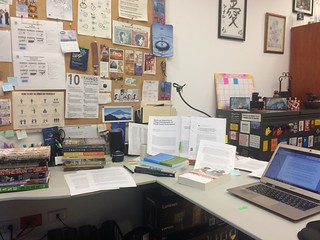 Whenever I read conclusions of papers, both in my students’ papers as well as in journal articles and book chapters, I find that writers are so tired of writing and doing the research that they end up exhausted. As I often say, they have “run out of gas”. Conclusions read hasty and rushed. I decided to write a blog post on best practices to craft the conclusion section of a scholarly paper, not using one of mine, but looking at papers that I thought had a really solid concluding section.
Whenever I read conclusions of papers, both in my students’ papers as well as in journal articles and book chapters, I find that writers are so tired of writing and doing the research that they end up exhausted. As I often say, they have “run out of gas”. Conclusions read hasty and rushed. I decided to write a blog post on best practices to craft the conclusion section of a scholarly paper, not using one of mine, but looking at papers that I thought had a really solid concluding section.
When I read papers (both my students and those I peer-review), I notice that most people write a one-paragraph conclusion. I find those rather boring, and worrisome. This happens to me too, as I often run out of gas while writing and all I want is to get the damn paper out. When I write conclusions, I am also very clear about the limitations of my study, potential improvements and “future research” issues. I kept this practice from my doctoral dissertation writing. As I did in my blog post on how to write an abstract, and on the one on how to write the introduction of a research paper, I also asked for advice from #AcademicTwitter on this topic. I’ve included their advice too.
My first piece of advice is (as I outlined in this post on how to write a first paper draft real quick in 8 simple steps), is to write bits and pieces of the conclusion as you write the main body of the paper.
 Moreover, I extract ONE insight from each section of the paper regardless of whether it is a book chapter or a journal article. I find that grabbing a topic sentence from the Discussions/Analysis sections and expanding on that particular insight in the conclusion helps me summarize the entire paper itself. I use that insight as a “topic sentence” to create a paragraph that explains the contributions of my findings to our overall understanding.
Moreover, I extract ONE insight from each section of the paper regardless of whether it is a book chapter or a journal article. I find that grabbing a topic sentence from the Discussions/Analysis sections and expanding on that particular insight in the conclusion helps me summarize the entire paper itself. I use that insight as a “topic sentence” to create a paragraph that explains the contributions of my findings to our overall understanding.
To me, conclusion sections are supposed to help the writer “finish off”, “bring everything together” they are supposed to re-center the paper’s discussions and explain how what we’ve found actually connects with the overall literature and the field. The first sentence of my conclusions’ sections usually reads as a global summary of the paper’s goals: “in this paper, I discussed polycentricity as a theoretical framework through which we can see multilevel water governance.”
As for concluding sections of entire book manuscripts, I’ll use my PhD thesis as an example. When I wrote the conclusion to my doctoral dissertation, I grabbed the conclusion of each chapter and I distilled ONE insight from that chapter to create the introduction to the concluding chapter. Then I created sections per dissertation chapter and summarized what I learned. I have seen this done with other books too.
Continuing with my Conclusions of Papers thread: I will use @buenosdiez 's paper on antihomophobia campaigns in Mexico and framing as published in LARR https://t.co/1W5B0YYkr1 note how Jordi summarizes his entire study in the first paragraph of the conclusion. pic.twitter.com/IZ9CshunQu
— Dr Raul Pacheco-Vega (@raulpacheco) August 7, 2018
Note how in the second paragraph of his paper's conclusion, @buenosdiez explains why this research is relevant, how it can be more generalizable, which other policy areas can draw insights from it, etc. This is an important move to make in the conclusion (limitations/future work) pic.twitter.com/U01F7PbaUV
— Dr Raul Pacheco-Vega (@raulpacheco) August 7, 2018
The previous example is from a paper by Dr. Jordi Diez Mendez, a good friend of mine who is a professor at University of Guelph. The following one is from Nate Millington.
Another good example of a paper conclusion, this time using a paper by @nate_millington on a linear park project in Brazil, analyzed using urban political ecology and forced-displacement literature. pic.twitter.com/va6NVCXQhf
— Dr Raul Pacheco-Vega (@raulpacheco) August 13, 2018
I purposefully didn’t highlight the introduction before tweeting about it (which I normally would do if I’m running an AIC Content Extraction) because I wanted o highlight coherence between abstract and conclusion (which is posted here). Note how @nate_millington starts… pic.twitter.com/HY5NeL75te
— Dr Raul Pacheco-Vega (@raulpacheco) August 13, 2018
In the third paragraph, @nate_millington positions his paper within broader debates on megaprojects/infrastructure development in the global South. He also suggests modest ways in which insights from his research can be generalized to other contexts. On the actual paper…
— Dr Raul Pacheco-Vega (@raulpacheco) August 13, 2018
I like that @nate_millington cites authors from the global south and asks the same from other scholars, all the while situating his paper and research within global debates and dialogues on environmentally-and government infrastructure- induced forced displacement. pic.twitter.com/ZW7xpAWHen
— Dr Raul Pacheco-Vega (@raulpacheco) August 13, 2018
I usually maintain a Conceptual Synthesis Excel Dump on “stuff I like and I’m interested in but I don’t have the time to actually study”. Millington’s paper belongs to that CSED.
Some authors combine discussion and conclusion. When this happens I usually assume they have ran out of steam. pic.twitter.com/8LF8ol1Gdw
— Dr Raul Pacheco-Vega (@raulpacheco) August 30, 2018
Authors usually show different rhetorical moves in their conclusions, but most commonly they link what they say in the Introduction and Abstract to their Conclusion (which is why I recommend the Abstract-Introduction-Conclusion content extraction method for quick/speed/skim reading).
Continuing my thread on writing conclusions of papers: do note that conclusions usually reiterate and/or reframe concepts mentioned in the abstract and introduction. This example is by Tagat and Kapoor on religious nudging and sanitation in India. pic.twitter.com/Qc1iNRcC0d
— Dr Raul Pacheco-Vega (@raulpacheco) August 31, 2018
Note how in their Conclusion, Tagat and Kapoor highlight stuff that isn’t explicitly acknowledged in Abstract nor Introduction. Ethical considerations are key to the core of the paper but they aren’t revealed in A nor I. This is something they learned AFTER doing the research. pic.twitter.com/1dSLoqnUpF
— Dr Raul Pacheco-Vega (@raulpacheco) August 31, 2018
Tagat and Kapoor divided their Conclusion section into “Ethical Considerations” and “Practical Implications”. They began with ethics and waited until later to summarize the entire paper. Personally, I like this rhetorical move. Note how they reveal stuff that wasn’t in A nor I. pic.twitter.com/mxOwNU6pn0
— Dr Raul Pacheco-Vega (@raulpacheco) August 31, 2018
The paper below shows classic rhetorical moves connecting Abstract and Introduction to Conclusion sections.
Musemwa’s paper on sanitation and public health in Harare (Zimbabwe) offers a classic “drawn from abstract, lessons learned expanded in conclusion” example. Note how Musemwa interweaves cholera outbreaks with poor urban planning and localism as well as state political tensions. pic.twitter.com/HbBYZd4OKb
— Dr Raul Pacheco-Vega (@raulpacheco) August 31, 2018
Note how Musemwa uses the paper’s Conclusion section to summarize BUT (note the “but was largely exacerbated”) also spell out additional insights drawn from conducting the research. This is a powerful rhetorical move: what did YOU learn from writing this? pic.twitter.com/2AQw3lkzH9
— Dr Raul Pacheco-Vega (@raulpacheco) August 31, 2018
Hopefully, armed with the examples I’ve outlined in this post, readers of my blog may be better positioned to write the conclusion section of their papers.

0 Responses
Stay in touch with the conversation, subscribe to the RSS feed for comments on this post.